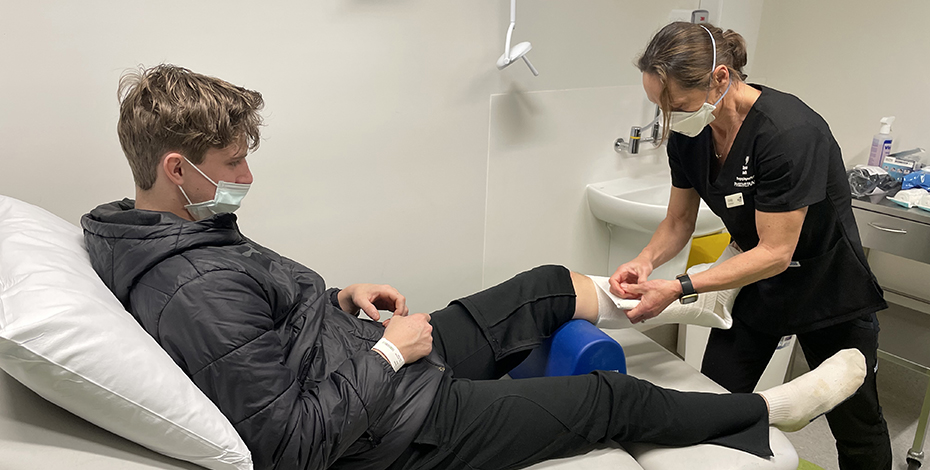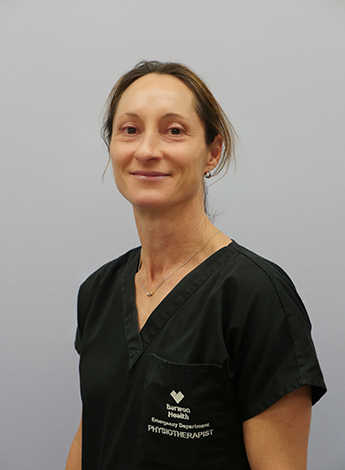
Physios in the Urgent Care Clinic

PRIMARY CARE The success of a primary contact physiotherapy service established in a Geelong Urgent Care Clinic suggests an effective approach for the future, explain physiotherapists Mark Napper and Emily Bradshaw.
Medicare Urgent Care Clinics (UCCs) sit in the gap between GP clinics and hospital emergency departments (EDs) and are designed to relieve pressure on hospital care.
These services are currently led by GPs under a Medicare-rebated model and manage a wide range of illnesses and injuries.
In the 2023–24 federal Budget, additional funding was announced to increase the number of UCCs to 58 Australia-wide and to expand the days and hours of existing clinic services.
The APA is now advocating for physiotherapists to work in a primary contact role to manage musculoskeletal conditions presented to UCCs.
Urgent care in Geelong In the northern suburbs of Geelong, Victoria, the development of a health service-led UCC was proposed in 2014 as a way of diverting some non-emergency ambulatory care away from the ED at Barwon Health’s University Hospital Geelong (UHG).
The UCC opened in January 2020 as a daily service, initially led by registered nurses and nurse practitioners (NP), with the support of telehealth medical consultation provided by UHG senior
ED medical staff.
In 2008, Barwon Health successfully established a primary contact physiotherapy (PCP) daily service in the UHG ED that continues today.
Based on the success of this model, the inclusion of a PCP service was considered early in the design of the new UCC’s model of care.
Commencing in 2022, the current PCP service operates three days per week (Saturday to Monday,
10 am – 6.30 pm), matching the days and times when patients with musculoskeletal problems are most likely to present.

Mark Knapper
Increasing demand
Demand for service at the UHG ED continues to grow. Pre- pandemic, attendance increased by 6.5 per cent per year. In recent years this has slowed to 2.5 per cent per year, while acuity has risen significantly.
The population of Geelong is expected to grow by 40.1 per cent between 2023 and 2041 (an extra 113,000 potential consumers) (.id Community Demographic Resources 2023).
This unprecedented growth, combined with the increased complexity of ED presentations, will only put greater pressure on ED access.
This highlights the importance of giving ambulatory patients with lower acuity presentations alternative options for accessible care. It also underlines the need to utilise the skills of all health workers to alleviate some of the burden of this demand on medical staff.
The UCC is a walk-in ambulatory care service.
It does not receive ambulance presentations.
Clinical care is collaboratively delivered by primary contact physiotherapists, nurse practitioners, registered nurses and radiographers.
Registered nurses undertake an initial triage assessment and establish urgency, measured against the Australasian Triage Scale. Patients with an Australasian Triage Scale score of 3–5 who meet the scope of practice of the service are seen in urgent care.
Patients who are assessed as having an Australasian Triage Scale score of 1–2 or who don’t meet the scope are referred on to UHG ED or their GP, via private car or ambulance as appropriate.
Medical escalation support is provided by the Barwon Health Acute Referral Service, delivered by ED physicians via telehealth.
Patients are then seen by the PCP or NP based on clinical scope and workflow.
Complementary imaging services are available onsite.
If urgent advanced imaging such as CT or MRI is required, patients are transferred to the UHG ED.
Clinical decision-making is supported by ED consultant-led telehealth.
Infrastructure and consumables (eg, splinting and plastering materials and gait aids) are available onsite to enable immediate treatment of all common presentations.
Post-discharge follow-up is via local GP, public or private outpatient allied health clinics or specialist outpatient clinics, as clinically indicated.

Emily Bradshaw
Physiotherapy service
The PCP service operates Saturday to Monday, which are traditionally the days with the greatest number of presentations meeting the physiotherapy scope of practice.
Presentations are generally dominated by injuries associated with children’s and adults’ sport, misadventure and ‘DIY weekend warriors’.
The days and hours of service have the potential to expand as the overall service grows.
The scope of practice is aligned with the Barwon Health ED PCP service, with minor variations determined by environmental and human resources.
Both adult and paediatric patients are seen within the service.
All simple trauma (sprains/strains, simple fractures and simple dislocations) and musculoskeletal presentations without significant red flags meet the scope of practice.
An audit by Gill and Stella (2013) of presentation to the UHG ED demonstrated that the five most frequent presentations seen by the PCP service were:
- fractures of the wrist
- sprains/strains of the ankle
- low back pain/sciatica/sprains/strains of the back
- fractures of the hand
- sprains/strains of the knee.
Current barriers to a fully independent PCP scope of practice in urgent care settings include:
- a lack of prescribing and administration rights for analgesia, local anaesthetics and simple antibiotics
- a lack of prescribing and administration rights for nitrous oxide gas in procedures such as relocating a dislocated joint
- not being able to provide an initial assessment for WorkCover certification
- provider numbers not being recognised for referral to private specialist follow-up.
This is overcome by working collaboratively with the NPs, registered nurses and ED consultant telehealth support. In a Medicare UCC environment, physiotherapy scope of practice could equally be supported by GPs, NPs and practice nurses as well as by state-based virtual EDs.
What’s in it for physiotherapy?
The PCP service in UCC provides yet another opportunity for physiotherapists to work at the top of their scope of practice.
When set up appropriately, with all relevant resources, it allows physiotherapists to make a significant contribution to the management of common urgent care presentations and, in doing so, to help manage the overall demand for ‘emergency’ services.
Along with established advanced practice roles in ED, orthopaedic, neurosurgical and paediatric care, this role highlights the opportunity for universities and other educational organisations to develop postgraduate training that is specific and relevant to physiotherapy advanced practice.
It also suggests a need for strong advocacy for physiotherapy in relation to prescribing rights in order to facilitate fully independent advanced practice. Prescribing rights would potentially increase the utility and efficiency of the PCP role.
Summary
The Geelong experience is an example of the successful implementation of a primary contact physiotherapy service within a UCC.
The essential elements for success are:
- a clearly defined scope of practice
- a training program that defines and measures competency against the scope of practice
- support from medical and NP staff to establish and maintain the role within the UCC
- clinic resources to support immediate patient management
- clear pathways for patient treatment escalation and post-discharge follow-up.
Mark Napper is a senior physiotherapist at Barwon Health with more than 15 years’ experience in advanced practice orthopaedics and emergency medicine.
Mark has postgraduate qualifications and implementation experience in evidence-based clinical redesign within the advanced practice setting.
Emily Bradshaw APAM is a senior physiotherapist at Barwon Health with more than 20 years’ experience in the emergency medicine setting, 10 of those in an advanced practice role. Emily is
a credentialled McKenzie physiotherapist and also works in private practice.
© Copyright 2025 by Australian Physiotherapy Association. All rights reserved.





